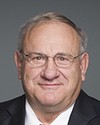Mr. Speaker, it really is a pleasure for me to speak to a motion like this one, because this was part of my daily life for many years for one simple reason: I am a nurse who worked primarily in acute and emergency care in a small, rural hospital. Every day, we had to face the reality that someone could suffer a cardiac arrest at any time, and sometimes they were 45 minutes away from the hospital. There are only two ambulances serving the entire RCM, which is about 100 kilometres across. It can sometimes take a very long time even for emergency responders to arrive.
Defibrillation does not really happen the way it looks in the movies, where the patient arrives at the hospital, we put the paddles on him and defibrillation occurs. For defibrillation to work, electrical currents still have to be going through the heart. If the patient flatlines, it is too late; nothing can be done and defibrillation will not work. That is why, if we want defibrillation to be effective, it must happen quickly, before the electrical currents in the heart stop following cardiac arrest.
It is good to have automated external defibrillators that are easy to use, not like those in hospitals that require training. These AEDS will save lives because people do not need much training to be able to use them effectively to reanimate someone. They will also help prevent the brain damage that can occur due to a lack of oxygen, as well as the harmful consequences that go along with that. The more quickly the defibrillator is used, the greater the chances of reanimation and the less severe the after-effects of the cardiac arrest and lack of oxygen.
This will have an impact on the number of lives saved and will reduce the severity of the consequences of a cardiac arrest. That is extremely important.
The motion refers to RCMP vehicles. Given that the indigenous police fall under our jurisdiction, I believe that we should also equip all of their vehicles with automated external defibrillators, particularly when we consider the fact that indigenous communities are often located in areas that are far from hospitals. For example, in my riding, the Long Point First Nation community is about 45 minutes from the hospital, when a person is driving fast. When weather conditions are not ideal, if there is a snowstorm, for example, it can easily take an hour and a half to get there.
I am certain that my colleague will agree with me that this should be extended to all emergency vehicles used by indigenous police and in all indigenous community gathering places, even though they are not mentioned in the motion. We could ensure that arenas, sports facilities, and all indigenous communities are also equipped with these defibrillators. I hope that the message will be passed on to the Minister of Indigenous Services so she can establish a strategy in that regard.
With respect to automated external defibrillators, it is important that they be available, but we must also discuss training for users. We must ensure that people know how to use them and where they are located. That makes a big difference because if the person has to look for the defibrillator, it will take longer. Members cannot answer me because this is not a question and comment period, but I am curious about how many people know exactly where the automated external defibrillator is located in the Parliament buildings. Does anyone here know? I am not so sure.
It is also very important for a communications plan to be put in place when automated external defibrillators are purchased so that everyone in the community can locate them quickly. Sometimes we believe that we have to know CPR and be very knowledgeable to save a life.
Just by knowing where an AED is located, people can help save a life by giving the device to someone who knows how to use it in under a minute. When a heart attack happens, the person who knows how to use the AED is often also the one who administers first aid to the victim. The first aider will start performing CPR and other techniques. If this person also has to go looking for an AED, valuable time will be lost. Making sure everyone knows where these devices are located can be highly beneficial.
A few years ago, there was a private foundation that had a program to help small communities buy AEDs. I passed on the information to small communities in my riding, and two AEDs were obtained through this program. I think private foundations that offer AEDs or help small municipalities buy them are extremely important. However, I also think that we need to play a major role in this issue. It is important to respect the jurisdictions of the provinces and other governments, but we can still play a leadership role, especially when we consider that lives are at stake and that this is a relatively simple thing to do. We can find solutions to make these devices more widely available.
I cannot overstate how much this would change things in rural communities like mine. I live in a rather remote area. When I give people my address they often get it wrong and never find their way. In more urgent situations, it might take longer to find my house. However, the local first responders know the area like the back of their hand and do not need an address. Just name the woman who needs help and they will get there in no time. If they are equipped with this device it might make the difference between hugging a friend and going to a funeral.
I sincerely hope that, in studying my colleague's motion, people will be able to set partisanship aside entirely. The motion deserves to be studied in committee because it can help us improve outcomes for Canadians. I also think that knowing that there can be a quick response will change a lot of things when it comes to people's health.
Unfortunately, heart attacks rarely occur in ideal circumstances. Most of the time, things do not go so well. I have seen cases where it happened to people who were hunting in the deep woods. That is not an ideal situation. Over the course of my career, only once have I witnessed someone having a heart attack right in the middle of triage. Lucky thing that happened in the ER. In real life, heart attacks do not happen in the ER. They happen in places where, most of the time, having access to an AED can change things for the better.
The majority of ambulances are now equipped with these devices, but considering the allocation of ambulance services in many rural communities, where few ambulances are available and wait times can be long in some cases, emergency response vehicles absolutely need to be equipped with these devices. We must also ensure that the first responders are properly trained in their use.
We can do a lot for people and I hope that we will move forward because it is a matter of life or death for Canadians. I hope that people will have a heart.









